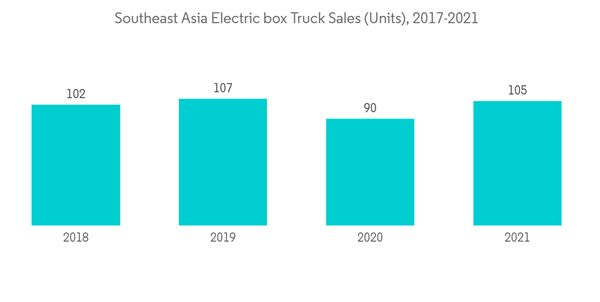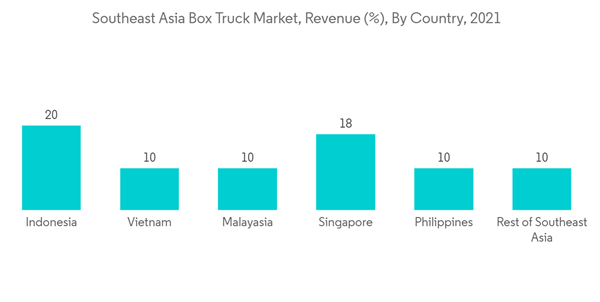Key Highlights
- The COVID-19 pandemic hindered the growth of the box truck market as the shutdown of manufacturing units coupled with supply chain disruptions resulted in decreased demand across various sectors like logistics, transportation, etc. However, the market started gaining traction post-pandemic, with most shares occupied by growing manufacturing activities across the country.
- Over the medium term, growing e-commerce and logistics sectors across the country will likely increase the demand for box trucks for transportation. The growing popularity of box trucks among the small restaurant to start food trucks across the country, which in turn is likely to witness significant growth for the market during the forecast period.
- Governments throughout the Southeast Asian region are putting pressure on vehicle manufacturers to reduce carbon emissions from diesel fuel combustion and address greenhouse gas emissions, compelling OEMs to invest in developing electric box trucks during the forecast period.
- Box trucks are becoming more popular among parcel service providers who deliver perishable goods and are likely to witness significant growth in the market during the forecast period. Box trucks often transport packages from one warehouse to another, where the parcels can then be loaded into delivery vans, which is anticipated to enhance the demand for box trucks during the forecast period.
Southeast Asia Box Truck Market Trends
Electric Box Trucks are dominating the market
- Governments play a pivotal role in encouraging the expansion of electric vehicle charging infrastructure. As the Southeast Asian governments push for further vehicle electrification, there must be usage and purchase incentives that either lower the overall cost of ownership or make driving electric vehicles more convenient for customers.
- Although there are few incentives for purchasing electric vehicles or charging infrastructure in the Philippines, the country holds 5% and 4% of worldwide nickel and cobalt reserves, respectively, and thus has enormous potential to participate more actively in the electric vehicle battery production value chain.
- EVs are becoming more popular in Indonesia, owing to ride-hailing companies like Grab, which recently announced a cooperation with local power supplier PLN to expand its fleet charging infrastructure. Public transportation operators such as Transjakarta want to increase their electric bus fleet to 10,000 units in the coming years.
- Governments of several countries decided to switch from the engine to electric to promote greener transportation across the country. In the context of zero carbon emission technologies, alternative fuel vehicles (AFV) offers significant energy-sustainable transportation and came up as a potential innovation to address the issue.
- For instance, in December 2022, the Transport Association’s President of Thailand announced to switch from diesel to electric trucks. T
- Singapore is leading the electric vehicle charging infrastructure with 1,800 public charging outlets accessible across the country and plans to add 60,000 charging sites by 2030. Between 2021 and 2025, the government allocated USD 22 million for initiatives to boost electric vehicle adoption and increase the reach of chargers on private property. This is likely to create an opportunity for electric box trucks during the forecast period.
- In addition, by permitting investments from conglomerates and start-ups to create a strong regional electric vehicle ecosystem, Singapore has successfully established itself as the region's core for research and development in the electric vehicle industry. With the aforementioned events and regional development, the market will likely experience significant expansion throughout the anticipated time.
Thailand and Indonesia are witnessing major growth
Thailand is the market leader and the biggest manufacturer in the region. The country faces competition from Indonesia, which aims to be the leading production hub. Thailand offers a low-cost manufacturing option to automakers. Most of the companies active in the region are focusing on expanding their fleet.The Thailand government is investing heavily toward converting their vehicle fleet, such as box trucks, into electric to reduce carbon emissions and improve air quality. Moreover, the region is expected to witness an increase in the demand for hybrid and electric vehicles due to the trade taxes on hybrid and electric vehicle parts and increasing launches and production of hybrid vehicle models in Southeast Asia prominently in Thailand.
Thailand is witnessing an increase in the number of quick service restaurants (QSR), the general push for healthier, fresh products by the government and their regulations w.r.t food preservation through organizations like FSAI, FSANZ, etc., and transportation of medical devices are likely to witness major growth for the refrigerated box trucks across the country. For instance,
- In December 2022, Santa Fe, one of the Food restaurant chains in Thailand expanded its quick-service restaurant with nine new branches across the country.
Singapore is a highly developed free economy, with an open and corruption-free business and a transparent legal framework. The Singapore government has set a new target worth USD 22 million between 2021-2025 to promote electric vehicle adoption among consumers and increase the number of chargers at private properties to robust the charging infrastructure across the country.
With the above-mentioned developments across the country is likely to witness significant growth for the market during the forecast period.
Southeast Asia Box Truck Market Competitor Analysis
Southeast Asia Box Truck Market is dominated by several key players such as Ford Motor Company, Mitsubishi Fuso Truck and Bus Corporation, Hino Motors Co. Ltd, and Many others. The rising expansion of truck manufacturers across the country will likely witness major market growth during the forecast period.In November 2022, Mitsubishi Fuso Truck and Bus Corporation announced that the official FUSO distributor of Indonesia, PT Krama Yudha Tiga Berlian Motors, will conduct customer trials of the all-electric light-duty eCanter truck in Bali, Indonesia starting in August 2022.
In June 2022, Mitsubishi Motors, Isuzu, FUSO, Nissan, and Toyota collaborated to popularise electrified vehicles in Indonesia by demonstrating a collaborative electrification ecosystem in Bali.
In March 2022, Hino Motors introduced Hino vehicles with common rail engine standards that are more robust, economical, and environmentally friendly and have complied with Euro4 regulations.
Additional benefits of purchasing the report:
- The market estimate (ME) sheet in Excel format
- 3 months of analyst support
This product will be delivered within 2 business days.
Table of Contents
Companies Mentioned (Partial List)
A selection of companies mentioned in this report includes, but is not limited to:
- Hino Motors Ltd
- Isuzu Motor Co. Ltd
- Mitsubishi Fuso Truck and Bus Corporatio
- Ford Motor Company
- Iveco Motor Group (CNH Industrial NV)
- Mercedes-Benz Group AG
- General Motors
- Fiat Chrysler Automobiles N.V.
Methodology

LOADING...










